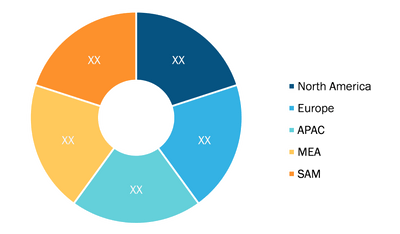According to our latest market study on “Airborne SATCOM Market Forecast to 2028 – COVID-19 Impact and Global Analysis – by Platform, Component, and Application,” the airborne SATCOM market is expected to grow from US$ 6,492.75 million in 2022 to US$ 10,390.96 million by 2028; it is estimated to grow at a CAGR of 8.2% from 2022 to 2028.
As the aviation industry in the 21st century is becoming ever more network-centric, satellite communication technology is moving to its next generation, along with the growing demand for this technology. A connected pilot should have network capabilities that allow real-time information sharing to meet mission requirements and preserve operational capabilities. Due to the large area of responsibility (AOR), communication in the air becomes difficult, is indicates the need for improved communication via SATCOM. The introduction of modern airborne SATCOM systems in commercial and military applications is driving demand for new aircraft. Air forces across the world emphasize network-centric warfare that permits communication across all sensors, weapons, and platforms spread across the battlefields. SATCOM is a vital component in creating and realizing network-centric capabilities for aircraft. The SATCOM technology design elements provide communication channels on air-to-ground, air-to-air, ship-to-air, and air-to-ship platforms. Communication satellite terminals make it easier to integrate communication networks on mobile platforms, helicopters, defense aircraft, and commercial aircraft. Airborne SATCOM systems continually undergo technological advancements to ensure high performance. For instance, in November 2019, the French Air Force enhanced its airborne satellite communication capabilities by adopting new technologies from Thales in the Rafale combat aircraft. Further, in June 2021, Honeywell offered JetWave MCX, an upgrade of the earlier JetWave products. The solution is specifically designed for military and governmental aircraft.
Impact of COVID-19 Pandemic on Airborne SATCOM Market Size
The COVID-19 pandemic resulted in disruptions in supply chains and a decline in aircraft manufacturing across various European countries due to lockdowns imposed by the European Union (EU) countries to curb the disease spread. The European military sector was hit hard by the high number of COVID-19 cases in 2020 and 2021. The pandemic also triggered a drop in the demand for defense aircraft, helicopters, and UAVs, resulting in reduced production. However, in contrast to the abovementioned factors, the European aircraft market players managed to acquire contracts related to various military and commercial aircraft worldwide, which enabled them to generate revenues. Nonetheless, the revenue generated in 2021 was comparatively less than in 2020. This negatively impacted the performances of the airborne SATCOM market players.
The US has the largest commercial, military, and general aviation fleets. The average age of its commercial aircraft fleet is close to 11 years, while that for military aircraft is over 26 years. The country accounts for the largest share in the airborne SATCOM market growth in North America due to the presence of aircraft manufacturers and the rising number of new and advanced airplanes in the country. The US has the largest defense budget in the world and a large share of the budget is contributed to the adoption and procurement of upgraded fighter planes. According to SIPRI, the country's military spending was 3.7% of GDP in 2020 and 3.5% in 2021. In 2021, Boeing delivered ~83 new and remanufactured AH-64 Apache attack helicopters, and 20 new and renewed CH-47 Chinook transport helicopters, which were made in the US. These developments in the aviation industry fuel the procurement of airborne SATCOM systems for the assembly of these aircraft.
The major end-users of the airborne SATCOM market include commercial aircrafts, military aircraft, business jets, helicopters, and unmanned aerial vehicles (UAVs), for government & defense, and commercial use. The SATCOM systems are largely used in the defense field to deliver cost-effective broadband communication services to aircraft operating at very high speeds. The end users are the key stakeholders of the airborne SATCOM market as it creates the demand for the product further, leveraging the airborne SATCOM market growth over the forecast period.
The airborne SATCOM market size is segmented on the basis of platform, component, application, and geography. Based on platform, the market share is segmented into commercial aircraft, military aircraft, helicopters, and UAVs. Based on component, the airborne SATCOM market is segmented into SATCOM terminals, transceivers, airborne radio, modems and routers, SATCOM radomes, and others. The airborne SATCOM market, by application, is segmented into defense and commercial. On the basis of geography, the market size is primarily segmented into North America, Europe, Asia Pacific (APAC), the Middle East & Africa (MEA), and South America.
Airbus SE; Thales Group; General Dynamics Mission Systems, Inc.; Honeywell International Inc.; and L3Harris Technologies, Inc are a few key airborne SATCOM market players. In addition, several other important companies were studied and analyzed during this study to get a holistic view of the global airborne SATCOM market and its ecosystem.
Airborne SATCOM Market Share – by Region, 2021

Airborne SATCOM Market Growth Report by 2031
Download Free Sample
Airborne SATCOM Market Size and Forecast (2021 - 2031), Global and Regional Share, Trend, and Growth Opportunity Analysis Report Coverage: By Platform (Commercial Aircraft, Military Aircraft, Helicopters, and UAV), By Component (SATCOM Terminals, Transceivers, Airborne Radio, Modems & Routers, SATCOM Radomes, and Others), By Application (Defense and Commercial), and Geography
Airborne SATCOM Market Growth Report by 2031
Download Free SampleAirborne SATCOM Market Size and Forecast (2021 - 2031), Global and Regional Share, Trend, and Growth Opportunity Analysis Report Coverage: By Platform (Commercial Aircraft, Military Aircraft, Helicopters, and UAV), By Component (SATCOM Terminals, Transceivers, Airborne Radio, Modems & Routers, SATCOM Radomes, and Others), By Application (Defense and Commercial), and Geography
Contact Us
Phone: +1-646-491-9876
Email Id: sales@theinsightpartners.com